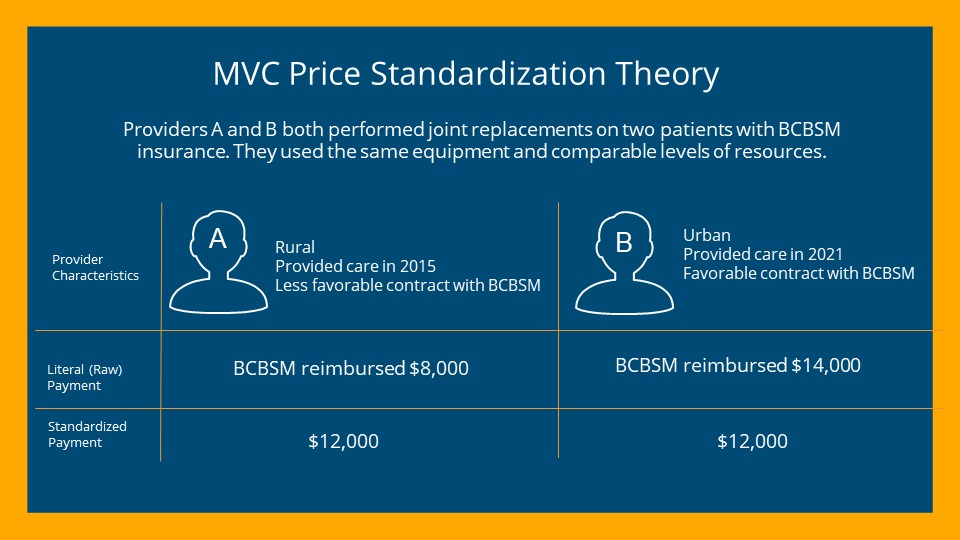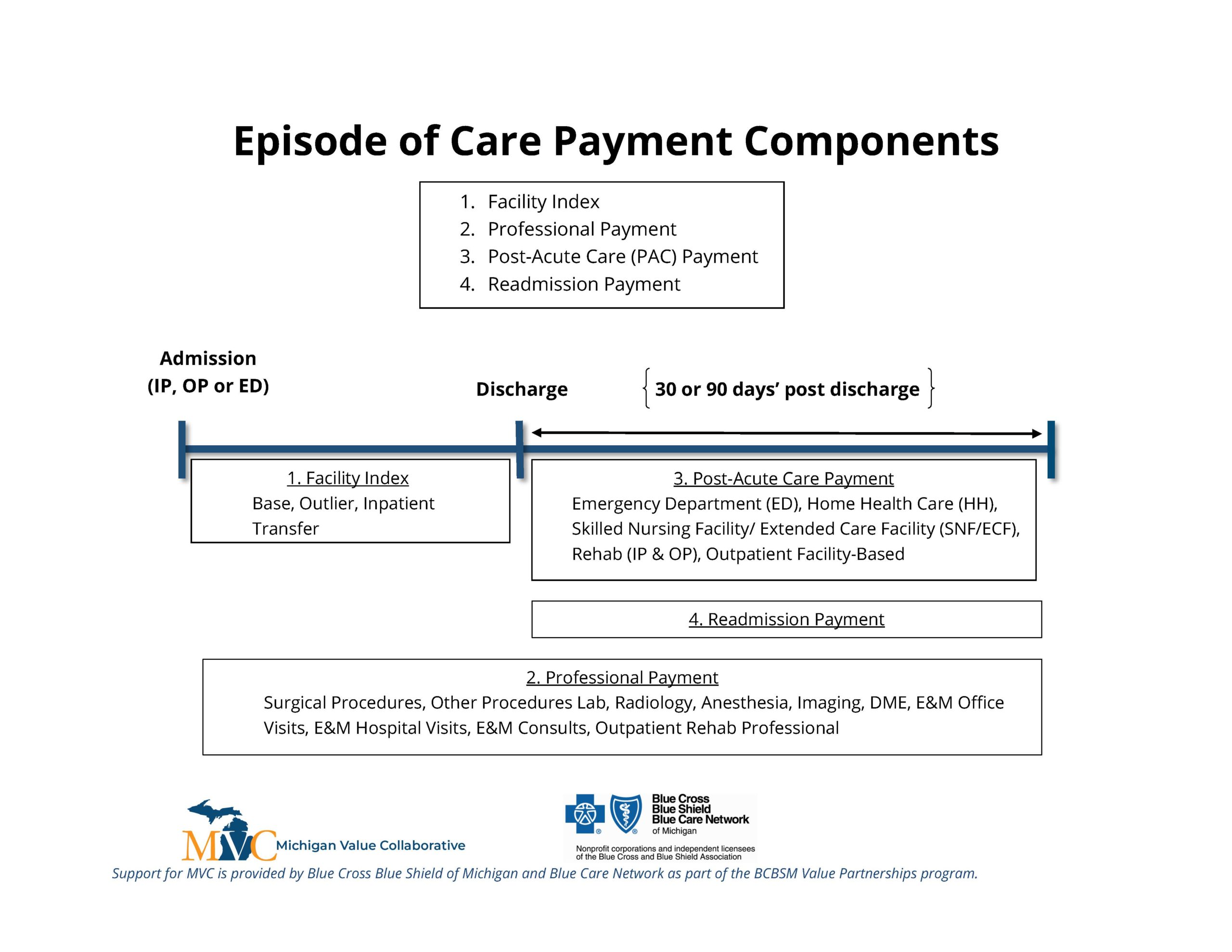Throughout the past few months, the MVC team has made several methodological updates to its claims-based episodes of care data underlying the metrics shared via MVC’s online registry and push reports. Some of these updates were part of regular claims data maintenance, whereas others were improvements identified and implemented by the MVC team.
Long-Term Acute Care Hospital Utilization Added as Post-Acute Care Category
A new category of post-acute care utilization was generated within MVC episodes of care: long-term acute care hospital (LTACH) stays. Previously, facility claims were grouped into seven major categories: inpatient, inpatient rehab, outpatient rehab, emergency department, skilled nursing facility, home health, and outpatient/other. An area of opportunity was identified by the MVC Coordinating Center and MVC members to add LTACH to this list. Formerly in MVC data, claims for stays at LTACH facilities were grouped in with inpatient claims and thus counted towards “inpatient readmissions” in the context of an MVC episode of care. LTACH is now its own category of care within MVC episodes and is assessed separately from inpatient stays at general acute care hospitals and Critical Access Hospitals. To count towards post-index LTACH care in an MVC episode, a facility claim must contain bill type 011X and the billing facility NPI for the claim must be primarily affiliated with taxonomy code 282E00000X. LTACH claims will continue to be price standardized in the same manner as other inpatient claims.
As a result of LTACH being added as a separate category of care in MVC episodes, MVC members can now also look at their patients’ use of LTACHs on the MVC registry. By index condition, members can view their attributed episodes’ rate of post-index LTACH utilization as well as their average LTACH payment per episode within the Payment by Condition reports for all payers. To do so, users must navigate to the Payment by Condition report, scroll down to the “Payment Measure” filter on the left side of the registry, and select “LTACH ($)” or “LTACH (%)” to look at average payments or utilization rates, respectively.
Updates to Hierarchical Condition Category (HCC) Identification
Another update made to MVC data this year was the application of components from the most recent specifications around hierarchical condition categories (HCC) from the Centers for Medicare & Medicaid Services (CMS). HCCs are patient comorbidities that both CMS and MVC use as part of risk-adjustment processes. When creating episodes of care, MVC uses each patient’s claims data in the 180 days prior to a given index event to retrospectively assess the comorbidities diagnosed for that patient prior to their MVC episode of care. Formerly, diagnoses indicated as “present on admission” on a patient’s index claim were also used to ascertain a patient’s HCCs, but MVC has updated its methodology such that no diagnoses from the index claim will be used in the assessment of patient HCCs going forward. MVC continues to create 79 HCCs according to HCC V22, with new diagnosis codes added each year.
Furthermore, we note that the category hierarchies created by CMS have been applied to the HCC comorbidities that MVC assesses and displays on the registry. The “hierarchical” aspect of the condition categories is applied to groups of similar diagnoses with a goal that patient comorbidities are not over-counted. For example, a patient diagnosed with diabetes may have multiple similar diagnoses reported on claims over a six-month period, such as diabetes without complications, diabetes with chronic complications, and diabetes with acute complications. Rather than describing that patient as having all three diagnoses, a hierarchy is applied so this patient will simply be described as having the most severe of the group of diagnoses (i.e., diabetes with acute complications). To look at the prevalence of HCC comorbidities among your patient population for one of MVC’s 40+ inpatient or surgical episodes of care, members can navigate to the “Comorbidities” report on the registry.
New Medicare Severity Diagnosis-Related Group (MS-DRG) Version
As part of annual maintenance to accommodate newly introduced billing codes, MVC recently updated the version of Medicare Severity Diagnosis Related Codes (MS-DRGs) being used to re-group inpatient claims into categories of similar inpatient stays. MS-DRG v40.1 is now being used by MVC to categorize all inpatient claims containing ICD-10-CM diagnosis codes and ICD-10-PCS procedure codes.
Inpatient Claim Outlier Length of Stay Methodology
MVC updated the method by which inpatient claims with a particularly long length of stay are identified and price standardized. MVC price standardizes each inpatient claim by adding up three components: a standard DRG-based payment, an inpatient transfer payment (if applicable), and a length of stay-based outlier payment (if applicable). An outlier payment is added to the total price-standardized payment amount for a given inpatient claim if the covered patient remained in the hospital significantly longer than an average patient with the same DRG. In the past, MVC identified these “outlier” long length of stay inpatient hospitalizations using publicly available national long length of stay thresholds for every DRG from TRICARE, the uniformed services healthcare program. MVC’s updated outlier methodology uses Medicare Fee-for-Service (FFS) claims to identify the 99th percentile in length of stay (days) among inpatient claims for each MS-DRG. The hospitalization length of stay on each inpatient claim is then compared against the newly identified 99th percentile threshold for the corresponding DRG. Claims with stays exceeding that length threshold are considered outliers. The outlier payment added to that claim’s price-standardized payment amount is then calculated with an unchanged formula as follows: Outlier Payment = (Number of Days Over DRG-Specific Length of Stay Threshold) * $2,500.
All-Cause Readmissions Assessed for All MVC Conditions
New this year, all-cause inpatient readmissions following index hospitalizations will be assessed for all MVC conditions whenever readmission metrics are shown. Specifications around the identification of readmissions will not vary by index condition.
Episodes Containing COVID-19 Care Now Identified by Primary Diagnosis Codes Only
Finally, MVC has modified the identification of episodes containing care for COVID-19. Episodes are now flagged as containing significant COVID-19 care if they meet the following criteria: at any point during the 30- or 90-day episode, a COVID-19 diagnosis (U07.1) was found in the primary diagnosis code position on a facility claim categorized as inpatient, inpatient rehab, skilled nursing facility, or LTACH. These episodes are often excluded from metrics displayed in MVC push reports. To exclude episodes containing COVID-19 care from metrics shown on the registry, members can use the registry filter called “COVID Cases.” Users should select “Exclude 30-Day COVID” to exclude episodes in which COVID-19 was found within the index event or 30 days post-index. Selecting “Exclude 90-Day COVID” will exclude episodes where a primary COVID-19 diagnosis was found within the index event or 90 days post-index.
For more information on MVC episodes of care data, please refer to MVC’s data guide. MVC members with questions not covered within the data guide are welcome to reach out to the Coordinating Center at Michigan-Value-Collaborative@med.umich.edu.



